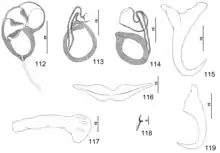Pseudorhabdosynochus mycteropercae
Pseudorhabdosynochus mycteropercae is a diplectanid monogenean parasitic on the gills of the tiger grouper, Mycteroperca tigris (Serranidae). It has been described by Kritsky, Bakenhaster and Adams in 2015. [1]
| Pseudorhabdosynochus mycteropercae | |
|---|---|
 | |
| Sclerotised parts | |
| Scientific classification | |
| Domain: | Eukaryota |
| Kingdom: | Animalia |
| Phylum: | Platyhelminthes |
| Class: | Monogenea |
| Order: | Dactylogyridea |
| Family: | Diplectanidae |
| Genus: | Pseudorhabdosynochus |
| Species: | P. mycteropercae |
| Binomial name | |
| Pseudorhabdosynochus mycteropercae Kritsky, Bakenhaster & Adams, 2015 | |
Etymology
The specific epithet is derived from the genus of the type-host, Mycteroperca tigris.
Description
Pseudorhabdosynochus mycteropercae is a small monogenean, about 700 µm in length. The species has the general characteristics of other species of Pseudorhabdosynochus, with a flat body and a posterior haptor, which is the organ by which the monogenean attaches itself to the gill of is host. The haptor bears two squamodiscs, one ventral and one dorsal. The sclerotized male copulatory organ, or "quadriloculate organ", has the shape of a bean with four internal chambers, as in other species of Pseudorhabdosynochus.[2] The vagina includes a sclerotized part, which is a complex structure.
Diagnosis
Kritsky, Bakenhaster & Adams (2015) wrote that Pseudorhabdosynochus mycteropercae differs from other members of the group of Pseudorhabdosynochus species infecting Mycteroperca species by having an open chamber of the vaginal sclerite (chamber of P. kritskyi, P. capurroi, P. vascellum, and P. contubernalis is closed; in P. hyphessometochus, the closed anterior wall of the chamber is formed by the two overlapping ends of the chamber wall). In addition, the cavity of the chamber in P. vascellum is small (vs large in P. mycteropercae); the wall of the chamber in P. contubernalis has external projections (absent in P. mycteropercae); the distal portion of the distal tube of the vaginal sclerite is simply recurved in P. kritskyi, P. capurroi, and P. hyphessometochus (vs distal tube doubly recurved in P. mycteropercae).[1]
Hosts and localities

The type-host and only recorded host of Pseudorhabdosynochus mycteropercae is the tiger grouper, Mycteroperca tigris (Serranidae: Epinephelinae). The type-locality is 8 miles north-west of St. George’s Island, Bermuda.[1]
References
- Kritsky, Delane C.; Bakenhaster, Micah D.; Adams, Douglas H. (2015). "Pseudorhabdosynochus species (Monogenoidea, Diplectanidae) parasitizing groupers (Serranidae, Epinephelinae, Epinephelini) in the western Atlantic Ocean and adjacent waters, with descriptions of 13 new species". Parasite. 22: 24. doi:10.1051/parasite/2015024. ISSN 1776-1042. PMC 4536336. PMID 26272242.

- Kritsky, D. C. & Beverley-Burton, M. 1986: The status of Pseudorhabdosynochus Yamaguti, 1958, and Cycloplectanum Oliver, 1968 (Monogenea: Diplectanidae). Proceedings of the Biological Society of Washington, 99, 17-20. PDF
